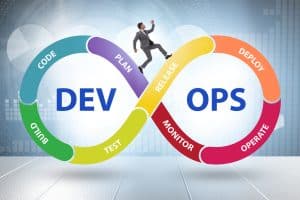
With proper planning, businesses can immerse themselves in DevOps and deliver top-quality software products at a magnitude that surpasses traditional practices.
All great things worth having are worth planning for, is a sentiment that rings true repeatedly in business. Anyone coordinating a successful DevOps implementation can rationalize that it requires time, planning, strategy, and vision. Overlook or rush any of these requirements for the sake of cost or effort, and the results will fall short.
With proper planning, businesses can immerse themselves in DevOps, with its unique framework and processes, and deliver top-quality software products at a magnitude that surpasses traditional practices.
Steps toward success
There are no shortcuts to implementing DevOps. Committing to what seems like the most straightforward tactics will underpin any transformation.
- Strategy
Forget any one-size-fits-all approach before it even begins. Every organization is different, and its needs, and methods available to fulfill those needs, vary. Often greatly. Thus, an organization must first identify its business requirements and objectives, which will involve regularly assessing its core revenue drivers, the challenges it faces, and the initiatives it’s planning. DevOps will be just one of many components here. The purpose of strategizing upfront is to determine how technology will advance the organization’s goals and how DevOps will serve to achieve them.

- Culture
When reviewing a business’ strategy, looking at where it’s been and where it’s going, the organization’s culture should readily come to light. Is there a history of everyone playing from the same sheet of music? Is there a tradition of choosing paths to success and sticking with them? Have teams and their members adapted well to change, or are they willing? Sorting through the culture of the organization will prepare it for the adoption of DevOps to come. Having everyone on the same page, working in unison on the same objectives will be essential.
A DevOps transformation may seem like a revolution against traditional software development, but once experienced, it’s more an evolution of the development culture. If that culture already functions transparently, with everyone understanding their importance, mentally and emotionally secure in a supportive environment, buy-in to the DevOps structure will result.
- Infrastructure
Adept DevOps teams will ultimately move fast, test early, release early and release often without compromising quality. And they’ll do this continuously. So infrastructure will play an indispensable role. Review existing tools and talents, identify what will be necessary and obtain whatever is lacking, rely upon those already in place by assigning them roles according to their strengths and potential, and prepare the solid foundation needed to achieve the business targets.
- Define Success
Reliable measurements and key metrics will repeatedly prove vital for qualifying success. Measures and metrics are equally important when transitioning to the DevOps environment, as they will be for every executed initiative once the transformation is complete. Business enablement measurement, cycle times, escaped defects, and many other metrics will be critical.
Described, DevOps is continuous testing, continuous integration, continuous delivery and continuous deployment of software. As noted above, implementing this innovative technological process requires time, planning, strategy, and vision.
The organization will identify company strategy and background. It will rank programs and priorities and identify main performance drivers. And upon building consensus, the organization will be squarely on the path to implementing DevOps. Along the journey, it will be imperative to choose dependable measurements that will verify successes throughout the transformation and operation.
See also: AIOps is An Essential DevOps Toolchain Component
Accept automation
Businesses will find themselves creating and refining products significantly faster in the DevOps environment than they ever did while using prior software development frameworks. This accomplishment will be attributed at least in part to successfully automating operations wherever possible. What companies will evaluate for automation is broad:
- Common business practices and how often they’re repeated.
- The necessary time to complete each process.
- The number of people and resources involved in operations.
- Delays in integration, deployment, or elsewhere that automation can address.
- Errors that automation can reduce or eliminate.
- Possible cost savings through automation.
- Time window or urgency for automating selected processes.
A complex landscape that’s woven among the cloud/multi-cloud and on-premises will amplify implementation issues. It raises challenges for creating the best methods to manage the pre-and post-implementation of DevOps. But building that successful approach will rely upon automation and dependable, high-quality data especially.
Dynamic solution for diverse objectives
Every organization that selects a DevOps solution must match it with their business purposes, such as the software applications they deploy. For example, for those who intend to build incomparable software, DevOps will be the conduit for connecting it to the market at unsurpassed speed. It will be the tool to manage the entire lifecycle, even as the product matures in use.
Precisely, DevOps orchestrates the building, configuration, and deployment of software. Simultaneously, it synchronizes software integration, testing, patching, and monitoring.
These examples of the roles that DevOps plays reflect why a one-size-fits-all plan won’t be compatible with its implementation. There are best practices, however, and obtaining insight from earlier adapters of DevOps is advantageous.
Professional DevOps advisors bring such experience in tow, like first-hand onboarding and troubleshooting scenarios, best practices from other organizations’ implementations, and many additional insights. They often have an excellent understanding of prior adopters of DevOps and share achievement benchmarks that lend perspective to an organization falling short of complete adaptation. Professional involvement also helps center company strategy with its background, rank its programs and priorities, identify performance drivers and build consensus when necessary.
Most companies that choose DevOps do so with an overriding purpose in mind: deliver better quality services at a faster pace.
When managed correctly, DevOps is the most powerful tool available in modern software development.
Navigating this course will reveal and distance successful organizations from their more rigid competitors and peers. Ultimately, the successful ones will prove they have the will and capacity to be flexible, embrace, and execute purposefully. They’ll exhibit the agility at the core of DevOps to quickly achieve scalability and ensure the organizations stay ahead of the competitive curve.




























